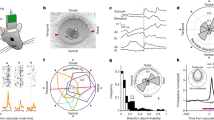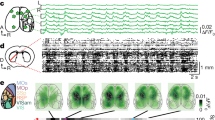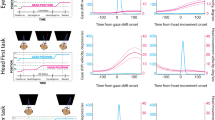Abstract
Each of our movements activates our own sensory receptors, and therefore keeping track of self-movement is a necessary part of analysing sensory input. One way in which the brain keeps track of self-movement is by monitoring an internal copy, or corollary discharge, of motor commands1,2,3,4,5,6,7,8,9,10,11,12,13. This concept could explain why we perceive a stable visual world despite our frequent quick, or saccadic, eye movements: corollary discharge about each saccade would permit the visual system to ignore saccade-induced visual changes6,7,8,9. The critical missing link has been the connection between corollary discharge and visual processing. Here we show that such a link is formed by a corollary discharge from the thalamus that targets the frontal cortex. In the thalamus, neurons in the mediodorsal nucleus relay a corollary discharge of saccades from the midbrain superior colliculus to the cortical frontal eye field10,11,12. In the frontal eye field, neurons use corollary discharge to shift their visual receptive fields spatially before saccades14,15. We tested the hypothesis that these two components—a pathway for corollary discharge and neurons with shifting receptive fields—form a circuit in which the corollary discharge drives the shift. First we showed that the known spatial and temporal properties of the corollary discharge predict the dynamic changes in spatial visual processing of cortical neurons when saccades are made. Then we moved from this correlation to causation by isolating single cortical neurons and showing that their spatial visual processing is impaired when corollary discharge from the thalamus is interrupted. Thus the visual processing of frontal neurons is spatiotemporally matched with, and functionally dependent on, corollary discharge input from the thalamus. These experiments establish the first link between corollary discharge and visual processing, delineate a brain circuit that is well suited for mediating visual stability, and provide a framework for studying corollary discharge in other sensory systems.
This is a preview of subscription content, access via your institution
Access options
Subscribe to this journal
Receive 51 print issues and online access
$199.00 per year
only $3.90 per issue
Buy this article
- Purchase on Springer Link
- Instant access to full article PDF
Prices may be subject to local taxes which are calculated during checkout




Similar content being viewed by others
References
Teuber, H.-L. in The Frontal Granular Cortex and Behavior (eds Warren, J. P. & Akerts, K.) 410–444 (McGraw-Hill, New York, 1964)
Delcomyn, F. Corollary discharge to cockroach giant interneurons. Nature 269, 160–162 (1977)
Poulet, J. F. & Hedwig, B. A corollary discharge maintains auditory sensitivity during sound production. Nature 418, 872–876 (2002)
Bell, C. C. in Comparative Physiology: Sensory Systems (eds Bolis, L. & Keynes, R. D.) 637–646 (Cambridge Univ. Press, Cambridge, 1984)
Thier, P., Haarmeier, T., Chakraborty, S., Lindner, A. & Tikhonov, A. Cortical substrates of perceptual stability during eye movements. Neuroimage 14, S33–S39 (2001)
Wurtz, R. H. & Sommer, M. A. Identifying corollary discharges for movement in the primate brain. Prog. Brain Res. 144, 47–60 (2004)
Von Helmholtz, H. Helmholtz’s Treatise on Physiological Optics (Thoemmes, Bristol, 2000)
Sperry, R. W. Neural basis of the spontaneous optokinetic response produced by visual inversion. J. Comp. Physiol. Psychol. 43, 482–489 (1950)
Von Holst, E. & Mittelstaedt, H. Das Reafferenzprinzip. Wechselwirkungen zwischen Zentralnervensystem und Peripherie. Naturwissenschaften 37, 464–476 (1950)
Sommer, M. A. & Wurtz, R. H. What the brain stem tells the frontal cortex. I. Oculomotor signals sent from superior colliculus to frontal eye field via mediodorsal thalamus. J. Neurophysiol. 91, 1381–1402 (2004)
Sommer, M. A. & Wurtz, R. H. What the brain stem tells the frontal cortex. II. Role of the SC–MD–FEF pathway in corollary discharge. J. Neurophysiol. 91, 1403–1423 (2004)
Sommer, M. A. & Wurtz, R. H. A pathway in primate brain for internal monitoring of movements. Science 296, 1480–1482 (2002)
Guthrie, B. L., Porter, J. D. & Sparks, D. L. Corollary discharge provides accurate eye position information to the oculomotor system. Science 221, 1193–1195 (1983)
Umeno, M. M. & Goldberg, M. E. Spatial processing in the monkey frontal eye field. I. Predictive visual responses. J. Neurophysiol. 78, 1373–1383 (1997)
Umeno, M. M. & Goldberg, M. E. Spatial processing in the monkey frontal eye field. II. Memory responses. J. Neurophysiol. 86, 2344–2352 (2001)
Duhamel, J. R., Colby, C. L. & Goldberg, M. E. The updating of the representation of visual space in parietal cortex by intended eye movements. Science 255, 90–92 (1992)
Kusunoki, M. & Goldberg, M. E. The time course of perisaccadic receptive field shifts in the lateral intraparietal area of the monkey. J. Neurophysiol. 89, 1519–1527 (2003)
Nakamura, K. & Colby, C. L. Updating of the visual representation in monkey striate and extrastriate cortex during saccades. Proc. Natl Acad. Sci. USA 99, 4026–4031 (2002)
Sparks, D. L. & Hartwich-Young, R. in The Neurobiology of Saccadic Eye Movements; Reviews of Oculomotor Research Vol. III (eds Wurtz, R. H. & Goldberg, M. E.) 213–255 (Elsevier, Amsterdam, 1989)
Hanes, D. P. & Schall, J. D. Countermanding saccades in macaque. Vis. Neurosci. 12, 929–937 (1995)
Lomber, S. G. The advantages and limitations of permanent or reversible deactivation techniques in the assessment of neural function. J. Neurosci. Methods 86, 109–117 (1999)
Sommer, M. A. & Wurtz, R. H. Composition and topographic organization of signals sent from the frontal eye field to the superior colliculus. J. Neurophysiol. 83, 1979–2001 (2000)
Lynch, J. C., Hoover, J. E. & Strick, P. L. Input to the primate frontal eye field from the substantia nigra, superior colliculus, and dentate nucleus demonstrated by transneuronal transport. Exp. Brain Res. 100, 181–186 (1994)
Acknowledgements
This research was supported by the Intramural Research Program of the NIH and the NEI. Author Contributions Both authors designed the experiments, M.A.S. performed and analysed them, and both authors wrote the paper.
Author information
Authors and Affiliations
Corresponding author
Ethics declarations
Competing interests
Reprints and permissions information is available at www.nature.com/reprints. The authors declare no competing financial interests.
Supplementary information
Supplementary Notes
This file contains Supplementary Methods, Supplementary Notes, Supplementary References, Supplementary Discussion, and Supplementary Figures 1–8. (PDF 2365 kb)
Rights and permissions
About this article
Cite this article
Sommer, M., Wurtz, R. Influence of the thalamus on spatial visual processing in frontal cortex. Nature 444, 374–377 (2006). https://doi.org/10.1038/nature05279
Received:
Accepted:
Published:
Issue Date:
DOI: https://doi.org/10.1038/nature05279
This article is cited by
-
Bilateral increase in MEG planar gradients prior to saccade onset
Scientific Reports (2023)
-
Stimulus edges induce orientation tuning in superior colliculus
Nature Communications (2023)
-
Professional chess expertise modulates whole brain functional connectivity pattern homogeneity and couplings
Brain Imaging and Behavior (2022)
-
Saccadic suppression in schizophrenia
Scientific Reports (2021)
-
A sensory memory to preserve visual representations across eye movements
Nature Communications (2021)
Comments
By submitting a comment you agree to abide by our Terms and Community Guidelines. If you find something abusive or that does not comply with our terms or guidelines please flag it as inappropriate.



